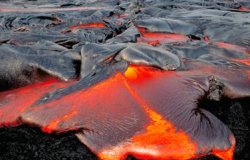
September Editorial
Hadean Earth re-assessed

September Editorial
Hadean Earth re-assessed
|
|
The Hadean is the earliest geologic eon which took place 4 billion years ago. The name of the eon comes from Hades, the 'hell' of classical mythology. This is because for most of the 20th century, it was believed that this early period on Earth's history was very hot and hostile. Molten magma was thought to cover most of the planet's surface and any solid rocks which did form were rapidly remelted. This belief in a molten earth was reinforced by the lack of evidence that any solid rock existed at that time, which suggested that the earth's crust was molten. |
|
|
However, challenges to the 'molten Earth' theory began in the 1980s when zircon crystals were discovered which were more that four billion years old. Zircons can be found in igneous rocks, metamorphic rocks and also in sedimentary deposits, so they are evenly distributed across the Earth’s crust. Zircons seem able to survive most geologic processes, including erosion, transport, and even high-grade metamorphism. A very useful property of zircons is their ability to accept high-field-strength elements. So Zirconium - which is one of the high-field-strength elements - can be substituted for another element, for example: Hafnium (Hf), Thorium (Th) or Uranium (U). Therefore, because zircons always contain traces of uranium and thorium,which have precisely measurable half-lives, zircons are used extensively for radiometric dating. But there is more to zircons than just radiometric dating. Other analytical techniques allow scientists to extract information about the environment in which the zircon crystals formed, for example the current temperature or whether water was present at the time. Once zircons 4,000,000,000 years old were discovered, scientists were therefore able to check the weather on pre-primeval Earth. Those studies showed that the early Earth environment was probably not as hostile as previously thought. There is now evidence that at least in some periods of the Hadean eon the Earth had a solid crust and very probably there was also liquid water on that surface. The data from zircons had led to the emergence of two new theories about the Hadean Earth:
The latter theory leads to analogies with modern Iceland. Iceland has a thick, juvenile, basaltic crust formed from magma that is much hotter than the magmas which have built most of the Earth’s existing continental crust. Interestingly, although this analogy has proven popular, until recently no-one had looked at zircons from Iceland and compared them to the ancient zircons. So recently geologists led by Professor Calvin Miller of Vanderbilt University, Nashville, USA decided to do just that. 'We reasoned that the only concrete evidence for what the Hadean was like came from the only known survivors: zircon crystals – and yet no one had investigated Icelandic zircon to compare their telltale compositions to those that are more than four billion years old, or with zircon from other modern environments', said Miller. More than one thousand zircon samples were collected from different areas of Iceland, spanning the island’s history and a range of tectonic settings. This was the very first extensive dataset comparison. The results showed that Icelandic zircons grew in magmas distinct from those in other locations on modern Earth, but more surprisingly also very different from those in which the Hadean zircons grew. When looking at oxygen values, it was clear that zircons from Iceland and ancient zircons both grew in the presence of water. However, quite counterintuitively, the oxygen signature was higher in ancient zircons - suggesting a wetter environment. Next the researchers compared the amount of titanium in zircons from those two different sources. Titanium levels appear to correlate well with the temperature at which the zircons crystallized. Again the values were very different (Icelandic median concentration 12 ppm, Hadean median 5 ppm) suggesting that the crystallization temperature of Icelandic zircons was higher than that of Hadean zircons. Studies of other trace elements gave further evidence that the compositions of respective magmas were different. As professor Miller summarizes: 'Our conclusion is counterintuitive. ….Hadean zircons grew from magmas rather similar to those formed in modern subduction zones, but apparently even 'cooler' and 'wetter' than those being produced today.' So rather than being a hellish mass of molten rock, early Earth might have been cool and somewhat damp - rather as people in the ancient world actually imagined Hades to be. Journal Reference: | |
| _______________________________ | ||||
| Home | | | Shopping | | | Database |
© Biscuit Software 2004-2015
All rights reserved